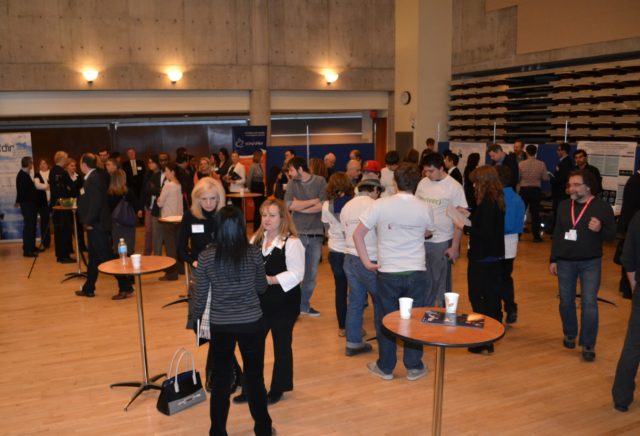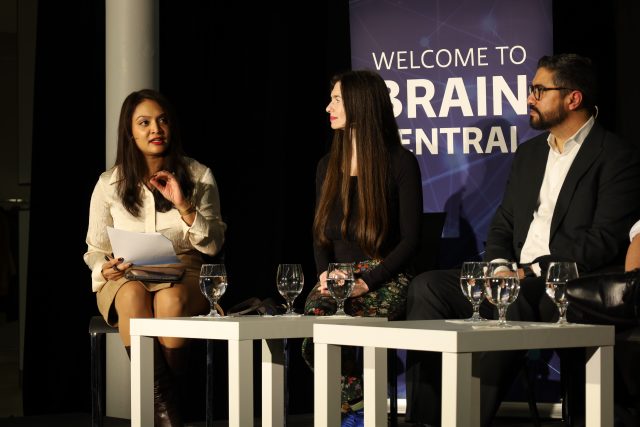Start from strength. Ontario neuroscience is recognized for research excellence, which is the foundation required for the development of a neurotechnology cluster. NeuroTech Ontario is the collective commitment of the growing neuroscience industry in the province to create technologies that leverage advances in brain research to improve public health, public understanding, and spur economic growth.
On February 10, 2014 the OBI held a special event at the YMCA Central in Toronto to celebrate the growth of NeuroTech Ontario. One of the successes of NeuroTech Ontario is its partnership with the Government of Canada’s Federal Economic Development Agency for Southern Ontario (FedDev Ontario).
The FedDev Ontario program serves to catalyze new public-private collaborations and to date, this partnership has approved almost $11M federal funding for 14 projects involving 12 research institutes and has attracted over $11M in matching funds from 16 private sector partners, including five international companies. These efforts have so far led to three product launches, significant economic development, and the creation of a number of game-changing neurotechnologies, many of which were showcased at the event.
People involved in Ontario’s flourishing neurotech industry gathered at the YMCA Central, to network and catch a sneak peek at some of the cutting-edge technology currently being developed. Among the NeuroTech Ontario projects on display were also current and former classes of OBI Entrepreneurs showcasing their progress. The year-long entrepreneurs program provides funding and training to recent graduates so that they can focus on commercialization activities related to a neuroscience-based opportunity— their accomplishments to date have been impressive. In just a few years these young scientists have made a smooth transition into the world of business, many of them well on their way to bringing new technologies to market. The event provided a great opportunity for people to learn about new Ontario-based technologies. Crowd members representing government, industry, education, and not-for-profit sectors, took advantage of the chance to chat with up-and-coming tech developers and the excitement in the room grew palpable as it was apparent that many of these emerging technologies are truly starting to push the boundaries of innovation—here are some of the highlights:
Could insights from big data help us test drugs virtually? The specialized software developers at Chematria have created a tool that will help pharmaceutical companies determine which molecules might make effective medicines. The use of this kind of technology will bring drugs to market faster with dramatically reduced development costs.
Virtual reality technology is also being used in other ways— representatives from KINARM were on site to explain how their technology can be used to assess brain injury. The KINARM™ consists of two robots which simultaneously track the movement of a person’s arms while they are given a series of tasks to carry out on a computer screen. Researchers can analyze different kinds of measurements over time to detect subtle changes in sensory, motor, and cognitive ability, allowing for more individualized treatment and rehabilitation plans for patients.
An equally intriguing tool from Sense Intelligent may soon help people who are hearing impaired experience sound through vision. As OBI entrepreneur Brian Hu explained, “We think this tool may prove to be more efficient than sign language and voice recognition technology. Our deaf-aid solution trains people to interpret not only speech, but music and ambient sounds as well. It’s also completely non-invasive and much less costly than a cochlear implant”.
To help avoid the extra cost and discomfort associated with overnight hospital visits, developers of ApneaDx Inc. have created a home diagnostic tool for sleep apnea. The disorder is characterized by abnormal pauses in breathing or instances of abnormally low breathing during sleep causing severe fatigue and other symptoms in those affected. It’s estimated that over half a billion people worldwide are affected by sleep apnea; however, many go undiagnosed. Visits to sleep clinics are costly and the home diagnostic tools that are currently available are cumbersome and still require set-up by a professional technician. In contrast, this light weight, cordless device efficiently gives people an accurate measure of their sleep patterns so doctors can better diagnose them.
OBI representatives were also present to provide a demo of the Neuroscience Asset Map— a virtual cluster tool that categorizes over 800 researchers, 150 neuroscience-related companies, and over 100 institutions involved in neuroscience-related fields in Ontario. OBI presented another important tool for researchers and innovators – Brain-CODE. This powerful data and analytics platform is being developed to take brain research collaboration to a whole new level, helping to broaden the scope of possibilities for the advancement of new, innovative technologies and truly make this a globally competitive NeuroTech Ontario.
A special announcement from Thriver capped off the morning event. Thriver™ is an online learning platform aimed at the cognitive development of children, developed in partnership with the University of Windsor. In addition to their product launch for Thriver™, this company also recently established not just one but three new major channel partners: the YMCA Academy, Scholar’s Choice, and Beyond the Classroom Ltd. Each of these partners is eager to use Thriver™ to better serve the needs of the children, parents, and educators they work with. This marks a major milestone for the FedDev Ontario-OBI program and a great success for the neurotechnology industry in Ontario.
While each company that was present is focused on developing a unique kind of technology, they are all working towards the common goal of developing products and services to improve care for Ontarians and people world-wide.
Back to Brainnovations Newsletter

